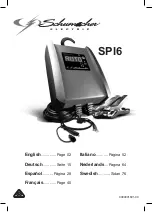
sive gases of a battery. There is a risk of an
explosion.
Before handling the battery, touch the vehicle
body to remove any existing electrostatic
build-up.
The highly flammable gas mixture is formed
when charging the battery or jump-starting
the vehicle.
Always make sure that neither you nor the
battery is electrostatically charged. Electro-
static charge is caused, for example, by:
R
wearing synthetic clothing
R
the friction of clothing on the seat
R
pulling or sliding the battery over carpets
or other synthetic materials
R
rubbing the battery with a cloth
G
WARNING
During the charging process, a battery produ-
ces hydrogen gas. If a short circuit occurs or
sparks are created, the hydrogen gas can
ignite. There is a risk of an explosion.
R
Make sure that the positive terminal of a
connected battery does not come into con-
tact with vehicle parts.
R
Never place metal objects or tools on a bat-
tery.
R
It is important that you observe the descri-
bed order of the battery terminals when
connecting and disconnecting a battery.
R
When jump-starting, make sure that the
battery poles with identical polarity are
connected.
R
It is particularly important to observe the
described order when connecting and dis-
connecting the jump leads.
R
Never connect or disconnect the battery
terminals while the engine is running.
G
WARNING
Battery acid is caustic. There is a risk of injury.
Avoid contact with the skin, eyes or clothing.
Do not inhale any battery gases. Do not lean
over the battery. Keep children away from
batteries. Wash battery acid immediately with
water and seek medical attention.
H
Environmental note
Batteries contain pollutants.
It is illegal to dispose of them
with the household rubbish.
They must be collected sep-
arately and disposed of in an
environmentally responsible
recycling system.
Dispose of batteries in an
environmentally responsible
manner. Take discharged
batteries to a qualified spe-
cialist workshop or to a col-
lection point for used batter-
ies.
!
Have the battery checked regularly at a
qualified specialist workshop.
Observe the service intervals in the Service
Booklet or contact a qualified specialist
workshop for more information.
!
Always have work on the battery carried
out at a qualified specialist workshop.
Should it, in exceptional circumstances, be
absolutely necessary to disconnect the bat-
tery yourself, please observe the following:
R
switch off the engine and remove the
key. Check that all the indicator lamps in
the instrument cluster are off. Otherwise,
you may damage electronic components
such as the alternator, for example.
R
first, disconnect the negative terminal
clamp, followed by the positive terminal
clamp. Never swap the terminal clamps.
The vehicle electronics may otherwise be
damaged.
R
on vehicles with automatic transmission,
the transmission is locked in position
P
after disconnecting the battery. The vehi-
cle is secured against rolling away. You
can then no longer move the vehicle.
Battery (vehicle)
305
Breakdown assistance
Z
Summary of Contents for 2012 A-Class
Page 1: ...A Class Owner s Manual Nur für internen Gebrauch For internal use only ...
Page 4: ......
Page 28: ...26 ...
Page 40: ...38 ...
Page 74: ...72 ...
Page 92: ...90 ...
Page 284: ...282 ...
Page 285: ...Useful information 284 Engine compartment 284 Service 289 Care 290 283 Maintenance and care ...
Page 336: ...334 ...
Page 353: ...351 ...
Page 354: ...352 ...
















































